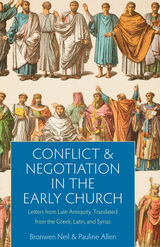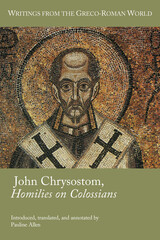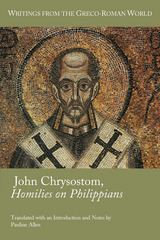3 books by Allen, Pauline

Conflict and Negotiation in the Early Church
Letters from Late Antiquity, Translated from the Greek, Latin, and Syriac
Bronwen Neil
Catholic University of America Press, 2020
Recent decades have seen great progress made in scholarship towards understanding the major civic role played by bishops of the eastern and western churches of Late Antiquity. Brownen Neil and Pauline Allen explore and evaluate one aspect of this civic role, the negotiation of religious conflict.
Conflict and Negotiation in the Early Church focuses on the period 500 to 700 CE, one of the least documented periods in the history of the church, but also one of the most formative, whose conflicts resonate still in contemporary Christian communities, especially in the Middle East.
To uncover the hidden history of this period and its theological controversies, Neil and Allen have tapped a little known written source, the letters that were exchanged by bishops, emperors and other civic leaders of the sixth and seventh centuries. This was an era of crisis for the Byzantine empire, at war first with Persia, and then with the Arab forces united under the new faith of Islam. Official letters were used by the churches of Rome and Constantinople to pursue and defend their claims to universal and local authority, a constant source of conflict. As well as the east-west struggle, Christological disagreements with the Syrian church demanded increasing attention from the episcopal and imperial rulers in Constantinople, even as Rome set itself adrift and looked to the West for new allies.
From this troubled period, 1500 letters survive in Greek, Latin, and Syriac. With translations of a number of these, many rendered into English for the first time, Conflict and Negotiation in the Early Church examines the ways in which diplomatic relations between churches were developed, and in some cases hindered or even permanently ruptured, through letter-exchange at the end of Late Antiquity.
Conflict and Negotiation in the Early Church focuses on the period 500 to 700 CE, one of the least documented periods in the history of the church, but also one of the most formative, whose conflicts resonate still in contemporary Christian communities, especially in the Middle East.
To uncover the hidden history of this period and its theological controversies, Neil and Allen have tapped a little known written source, the letters that were exchanged by bishops, emperors and other civic leaders of the sixth and seventh centuries. This was an era of crisis for the Byzantine empire, at war first with Persia, and then with the Arab forces united under the new faith of Islam. Official letters were used by the churches of Rome and Constantinople to pursue and defend their claims to universal and local authority, a constant source of conflict. As well as the east-west struggle, Christological disagreements with the Syrian church demanded increasing attention from the episcopal and imperial rulers in Constantinople, even as Rome set itself adrift and looked to the West for new allies.
From this troubled period, 1500 letters survive in Greek, Latin, and Syriac. With translations of a number of these, many rendered into English for the first time, Conflict and Negotiation in the Early Church examines the ways in which diplomatic relations between churches were developed, and in some cases hindered or even permanently ruptured, through letter-exchange at the end of Late Antiquity.
[more]

John Chrysostom, Homilies on Colossians
Pauline Allen
SBL Press, 2021
Pauline Allen translates Frederick Field's text of John Chrysostom's twelve homilies on Paul's Letter to the Colossians. Chrysostom concentrates in part on the apparently prevalent angel worship in Colossae (in modern Turkey). These homilies provide many details about everyday life in the late Roman period, such as the position of slaves and their treatment as well as various aspects of raising healthy, educated children. The themes of conflict between pagans, Jews, and Christians in the community, as well as the distinction between rich and poor in late antiquity, run throughout the homilies. This latest text and translation volume from WGRW is an essential resource for scholars and students interested in the history of the church.
[more]

John Chrysostom, Homilies on Philippians
Pauline Allen
SBL Press, 2013
This volume offers a translation of sixteen homilies by the most famous preacher in Christian antiquity, John Chrysostom. These homilies on Paul’s letter to the Philippians constitute the most comprehensive ancient surviving commentary on the letter in any language. The homilies have a direct and conversational style in which examples from daily life abound: children, the elderly, food, agriculture, seafaring, money, commerce, building, furniture, weather, illness, good health, animals, and slavery. Friendship themes, based on Paul’s relationship with the church at Philippi, and Christology also figure largely in these homilies. This volume, with Greek text and English translation on facing pages, situates Chrysostom’s homilies on Paul’s letter to the Philippians in their historical, homiletical, rhetorical, and liturgical contexts.
[more]
READERS
Browse our collection.
PUBLISHERS
See BiblioVault's publisher services.
STUDENT SERVICES
Files for college accessibility offices.
UChicago Accessibility Resources
home | accessibility | search | about | contact us
BiblioVault ® 2001 - 2024
The University of Chicago Press









